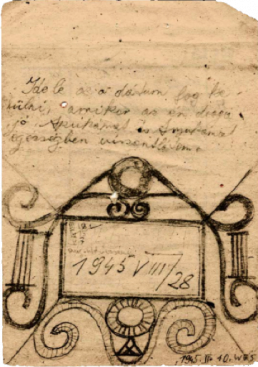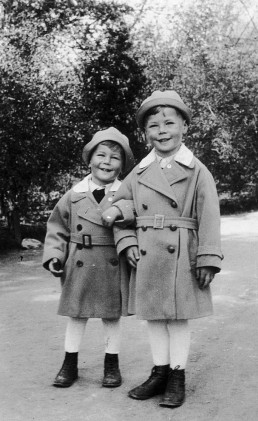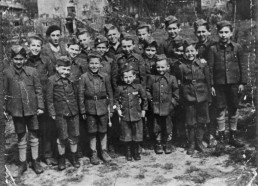In order to survive, children and adolescents in the camps needed the help of friends, family members or adult fellow prisoners. Especially for the children, bonds with other people were important in order not to lose the will to live. Relationships helped with the procurement of food and clothing. It could be life-saving to be assigned to a lighter work detail with the help of prisoner functionaries.
Most of the children and adolescents came to Buchenwald or Mittelbau-Dora alone. Only a few were accompanied by their parents or siblings. Some suffered the loss of their relatives in the camps.
"And down here I will write the date when I will see my dear and beloved mother and father again in health". Excerpt from the notes of Alex Hacker, 10 February 1945.
In his secret diary kept during his imprisonment in the Mittelbau-Dora Concentration Camp, Alex Hacker prepared an entry for the day of his return home, leaving a blank for the date. He was finally able to fill it in when he returned to his hometown of Budapest on 28 August 1945.
(private property)
Ludwig Hamburger:
The only good thing was, we didn't lose heart.
David Boder:
You didn't lose heart - how did that happen?
Ludwig Hamburger:
I always had my parents in mind [...] How I was a child [...] you have to stay brave and I always heard my mother and thought of my mother.
Ludwig Hamburger in an interview with David P. Boder, 28 August 1946.
Ludwig Hamburger was born in Katowice (Poland) in 1927. He and other young people from Katowice were deported to the Auschwitz Concentration Camp in 1941. In the winter of 1944, the SS sent him on a death march to Buchenwald. After the camp was liberated, he travelled on an aid transport to a Displaced Persons Camp in Geneva, Switzerland, where David Boder interviewed him in 1946. The last time he saw his mother was in 1941.
(„Voices of the Holocaust“, Illinois Institute of Technology)
Naftali Fürst (left) and his brother Shmuel in Bratislava, 1936.
The brothers Naftali and Shmuel Fürst arrived at Buchenwald from Auschwitz in January 1945. Prisoner functionaries saw that both boys were housed and protected in Children’s Block 66 in the Little Camp. Naftali was liberated there on April 11, while his brother Schmuel was sent by the SS on a death march and not liberated until early May 1945. The brothers reunited in Bratislava in the summer of 1945.
(private property)
"I always say that in the camps the easiest thing was to die, give up and die. The hard thing was to keep going and fight. And there we had to fight for our lives and every step was a struggle. And I can also say, I am convinced that because we were two brothers together, that helped us a lot. To be alone, a ten- or eleven-year- old child, I don’t think I could do that, because that would be terrible. We were dead tired, dead hungry, wet, you can't imagine."
Naftali Fürst in an interview in Haifa, 2009.
The two brothers Naftali and Shmuel Fürst survived the death march from Auschwitz Concentration Camp to Buchenwald in the winter of 1945 under the most adverse conditions. The brothers’ bond helped them in their struggle for survival.
(erinnern.at)
Friendship in the concentration camp: Ludwig Hamburger interviewed by David P. Boder, 26 August 1946.
Ludwig Hamburger and his friend survived a death march from the Auschwitz Concentration Camp to Buchenwald, where they were liberated. They subsequently went to Switzerland together.
(„Voices of the Holocaust“, Illinois Institute of Technology)
Liberated Jewish children in Buchenwald, 20 April 1945.
Second from the right in the second row is Markus Milstein. His brother Shraga was taken to Bergen-Belsen in January 1945 and liberated there. The Milstein brothers, like other boys in the photo, were from Piotrków Trybunalski and stayed together as a group in Buchenwald. The group included Israel Meir Lau (front row, second from right). He was the Ashkenazi Chief Rabbi of the State of Israel from 1993 to 2003.
(Buchenwald Memorial)
"I was part of the group. I was never really alone, and it helped because we had a common fate." Account by Shraga Milstein, February 2021.
In the interview, he mentions the photo from Buchenwald showing his liberated brother Markus.
(Buchenwald Memorial)
"There was this boy … and I become a little bit friendly with him, you know? This was end of ’42. End of ’44, or January 1945, when I go to this Kinder barrack in Buchenwald, the boy is there. I recognize him, you know? And he recognizes me. This is almost two years later. … The first thing he does, he takes out half of his bread and gives me. And you know, a piece of bread in Buchenwald, I can tell you is like life."
Piece of bread. Jack Aizenberg in an interview with the USC Shoah Foundation, 8 July 1997.
Jack Aizenberg was deported to Buchenwald as a 16-year-old in the winter of 1944. After liberation, he emigrated to Manchester, England, where he was placed in a home with other former Buchenwald prisoners. For some time he also lived there with his friend Pinchas Koronitz, whom he had met in Buchenwald.
(Visual History Archive)


